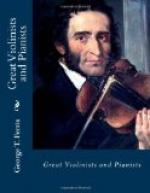It is not a matter of wonder that the lovers of the harpsichord and clavichord did not take kindly to the piano-forte at first. The keys needed a greater delicacy of treatment, and the very fact that the instrument required a new style of playing was of course sufficient to relegate the piano to another generation. The art of playing had at the time of the invention of the piano attained a high degree of efficiency. Such musicians as Do-menico Scarlatti in Italy and John Sebastian Bach in Germany had developed a wonderful degree of skill in treating the clavecin, or spinet, and the clavichord, and, if we may trust the old accounts, they called out ecstasies of admiration similar to those which the great modern players have excited. With the piano-forte, however, an entirely new style of expression came into existence. The power to play soft or loud at will developed the individual or personal feeling of the player, and new effects were speedily invented and put in practice. The art of playing ceased to be considered from the merely objective point of view, for the richer resources of the piano suggested the indulgence of individuality of expression. It was left to Emanuel Bach to make the first step toward the proper treatment of the piano, and to adapt a style of composition expressly to its requirements, though even he continued to prefer the clavichord. The rigorous, polyphonic style of his illustrious father was succeeded by the lyrical and singing element, which, if fantastic and daring, had a sweet, bright charm very fascinating. He writes in one of his treatises: “Methinks music ought appeal directly to the heart, and in this no performer on the piano-forte will succeed by merely thumping and drumming, or by continual arpeggio playing. During the last few years my chief endeavor has been to play the piano-forte, in spite of its deficiency in sustaining the sound, so much as possible, in a singing manner, and to compose for it accordingly. This is by no means an easy task, if we desire not to leave the ear empty or to disturb the noble simplicity of the cantabile by too much noise.”
Haydn and Mozart, who composed somewhat for the harpsichord (for until the closing years of the eighteenth century this instrument had not entirely yielded to the growing popularity of the piano-forte), distinguished themselves still more by their treatment of the latter instrument. They closely followed the maxims of Emanuel Bach. They aimed to please the public by sweet melody and agreeable harmony, by spontaneous elegance and cheerfulness, by suave and smooth simplicity. Their practice in writing for the orchestra and for voices modified their piano-forte style both as composers and players, but they never sacrificed that intelligible and simple charm which appeals to the universal heart to the taste for grand, complex, and eccentric effects, which has so dominated the efforts of their successors. Mozart’s most distinguished contemporaries bear




